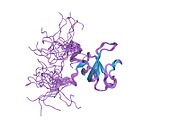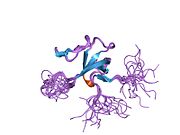CYLD (gene)
Appearance
CYLD lysine 63 deubiquitinase, also known as CYLD, is a human gene.[5]
This gene encodes a cytoplasmic protein with three cytoskeletal-associated protein-glycine-conserved (CAP-GLY) domains that functions as a deubiquitinating enzyme. Mutations in this gene have been associated with cylindromatosis, multiple familial trichoepithelioma, and Brooke–Spiegler syndrome. Alternate transcriptional splice variants, encoding different isoforms, have been characterized.[6] CYLD is evolutionary ancient and can be found back as far back as sponges.[7]
References
- ^ a b c GRCh38: Ensembl release 89: ENSG00000083799 – Ensembl, May 2017
- ^ a b c GRCm38: Ensembl release 89: ENSMUSG00000036712 – Ensembl, May 2017
- ^ "Human PubMed Reference:". National Center for Biotechnology Information, U.S. National Library of Medicine.
- ^ "Mouse PubMed Reference:". National Center for Biotechnology Information, U.S. National Library of Medicine.
- ^ "Symbol report for CYLD". www.genenames.org/. Retrieved 20 June 2019.
- ^ "Entrez Gene: CYLD cylindromatosis (turban tumor syndrome)".
- ^ Hadweh P, Chaitoglou I, Gravato-Nobre MJ, Ligoxygakis P, Mosialos G, Hatzivassiliou E (2018). "Functional analysis of the C. elegans cyld-1 gene reveals extensive similarity with its human homolog". PLOS ONE. 13 (2): e0191864. doi:10.1371/journal.pone.0191864. PMC 5796713. PMID 29394249.
{{cite journal}}: CS1 maint: unflagged free DOI (link)
Further reading
- Nakajima D, Okazaki N, Yamakawa H, Kikuno R, Ohara O, Nagase T (June 2002). "Construction of expression-ready cDNA clones for KIAA genes: manual curation of 330 KIAA cDNA clones". DNA Research. 9 (3): 99–106. CiteSeerX 10.1.1.500.923. doi:10.1093/dnares/9.3.99. PMID 12168954.
- Lian F, Cockerell CJ (2006). "Cutaneous appendage tumors: familial cylindromatosis and associated tumors update". Advances in Dermatology. 21: 217–34. doi:10.1016/j.yadr.2005.06.005. PMID 16350444.
- Biggs PJ, Wooster R, Ford D, Chapman P, Mangion J, Quirk Y, Easton DF, Burn J, Stratton MR (December 1995). "Familial cylindromatosis (turban tumour syndrome) gene localised to chromosome 16q12-q13: evidence for its role as a tumour suppressor gene". Nature Genetics. 11 (4): 441–3. doi:10.1038/ng1295-441. PMID 7493027. S2CID 33637152.
- Maruyama K, Sugano S (January 1994). "Oligo-capping: a simple method to replace the cap structure of eukaryotic mRNAs with oligoribonucleotides". Gene. 138 (1–2): 171–4. doi:10.1016/0378-1119(94)90802-8. PMID 8125298.
- Biggs PJ, Chapman P, Lakhani SR, Burn J, Stratton MR (March 1996). "The cylindromatosis gene (cyld1) on chromosome 16q may be the only tumour suppressor gene involved in the development of cylindromas". Oncogene. 12 (6): 1375–7. PMID 8649842.
- Suzuki Y, Yoshitomo-Nakagawa K, Maruyama K, Suyama A, Sugano S (October 1997). "Construction and characterization of a full length-enriched and a 5'-end-enriched cDNA library". Gene. 200 (1–2): 149–56. doi:10.1016/S0378-1119(97)00411-3. PMID 9373149.
- Nagase T, Ishikawa K, Suyama M, Kikuno R, Hirosawa M, Miyajima N, Tanaka A, Kotani H, Nomura N, Ohara O (December 1998). "Prediction of the coding sequences of unidentified human genes. XII. The complete sequences of 100 new cDNA clones from brain which code for large proteins in vitro". DNA Research. 5 (6): 355–64. doi:10.1093/dnares/5.6.355. PMID 10048485.
- Thomson SA, Rasmussen SA, Zhang J, Wallace MR (1999). "A new hereditary cylindromatosis family associated with CYLD1 on chromosome 16". Human Genetics. 105 (1–2): 171–3. doi:10.1007/s004390051083. PMID 10480375.
- Bignell GR, Warren W, Seal S, Takahashi M, Rapley E, Barfoot R, Green H, Brown C, Biggs PJ, Lakhani SR, Jones C, Hansen J, Blair E, Hofmann B, Siebert R, Turner G, Evans DG, Schrander-Stumpel C, Beemer FA, van Den Ouweland A, Halley D, Delpech B, Cleveland MG, Leigh I, Leisti J, Rasmussen S (June 2000). "Identification of the familial cylindromatosis tumour-suppressor gene". Nature Genetics. 25 (2): 160–5. doi:10.1038/76006. PMID 10835629. S2CID 22829077.
- Zhang QH, Ye M, Wu XY, Ren SX, Zhao M, Zhao CJ, Fu G, Shen Y, Fan HY, Lu G, Zhong M, Xu XR, Han ZG, Zhang JW, Tao J, Huang QH, Zhou J, Hu GX, Gu J, Chen SJ, Chen Z (October 2000). "Cloning and functional analysis of cDNAs with open reading frames for 300 previously undefined genes expressed in CD34+ hematopoietic stem/progenitor cells". Genome Research. 10 (10): 1546–60. doi:10.1101/gr.140200. PMC 310934. PMID 11042152.
- Trompouki E, Hatzivassiliou E, Tsichritzis T, Farmer H, Ashworth A, Mosialos G (August 2003). "CYLD is a deubiquitinating enzyme that negatively regulates NF-kappaB activation by TNFR family members". Nature. 424 (6950): 793–6. doi:10.1038/nature01803. hdl:21.11116/0000-0007-948F-1. PMID 12917689. S2CID 4424549.
- Brummelkamp TR, Nijman SM, Dirac AM, Bernards R (August 2003). "Loss of the cylindromatosis tumour suppressor inhibits apoptosis by activating NF-kappaB". Nature. 424 (6950): 797–801. doi:10.1038/nature01811. hdl:1874/17767. PMID 12917690. S2CID 4416878.
- Kovalenko A, Chable-Bessia C, Cantarella G, Israël A, Wallach D, Courtois G (August 2003). "The tumour suppressor CYLD negatively regulates NF-kappaB signalling by deubiquitination". Nature. 424 (6950): 801–5. doi:10.1038/nature01802. PMID 12917691. S2CID 4397177.
- Hu G, Onder M, Gill M, Aksakal B, Oztas M, Gürer MA, Celebi JT (October 2003). "A novel missense mutation in CYLD in a family with Brooke-Spiegler syndrome". The Journal of Investigative Dermatology. 121 (4): 732–4. doi:10.1046/j.1523-1747.2003.12514.x. PMID 14632188.
- Regamey A, Hohl D, Liu JW, Roger T, Kogerman P, Toftgard R, Huber M (December 2003). "The tumor suppressor CYLD interacts with TRIP and regulates negatively nuclear factor kappaB activation by tumor necrosis factor". The Journal of Experimental Medicine. 198 (12): 1959–64. doi:10.1084/jem.20031187. PMC 2194148. PMID 14676304.
- Zhang XJ, Liang YH, He PP, Yang S, Wang HY, Chen JJ, Yuan WT, Xu SJ, Cui Y, Huang W (March 2004). "Identification of the cylindromatosis tumor-suppressor gene responsible for multiple familial trichoepithelioma". The Journal of Investigative Dermatology. 122 (3): 658–64. doi:10.1111/j.0022-202X.2004.22321.x. PMID 15086550.
- Jono H, Lim JH, Chen LF, Xu H, Trompouki E, Pan ZK, Mosialos G, Li JD (August 2004). "NF-kappaB is essential for induction of CYLD, the negative regulator of NF-kappaB: evidence for a novel inducible autoregulatory feedback pathway". The Journal of Biological Chemistry. 279 (35): 36171–4. doi:10.1074/jbc.M406638200. PMID 15226292.
External links
- Human CYLD genome location and CYLD gene details page in the UCSC Genome Browser.











